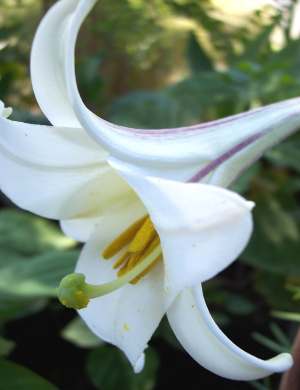|
Liliaceae
Lily Family
(Includes genera now placed in the following families: Alliaceae, Aloeaceae,
Asparagaceae, Asphodelaceae, Funkiaceae, Hyacinthaceae, etc.)
See also Amaryllidaceae
page.
Aloe affinis - Aloe - Tender
Perennial Succulent - One of the maculate aloes. Keep dry in winter
and place in a well-drained location in sun. Will recover from underground
stems after severe freezes if it does not rot.
Aloe aristata - Aloe - Perennial
Succulent - Keep dry in winter and place in a well-drained location in
sun. Will recover from underground stems after severe freezes if it does
not rot.
Aloe aristata X Aloe variegata
- Aloe - Perennial Succulent - Keep dry in winter and place in a well-drained
location in sun. Will recover from underground stems after severe freezes
if it does not rot.
Aloe branddraaiensis - Aloe
- Tender Perennial Succulent - Another of the maculate aloes. Keep
dry in winter and place in a well-drained location in sun. Will recover
from underground stems after severe freezes if it does not rot.
Aloe camperi - Includes plants
formerly known as: Aloe eru, Aloe eru var. cornuta, Aloe
camperi 'Cornuta' - Aloe - Tender Perennial Succulent - An Ethiopian
aloe which survives lows in the upper teens. Keep dry in winter and place
in a well-drained location in sun. Will recover from underground stems
after severe freezes if it does not rot.
Aloe dyeri - Aloe - Perennial
Succulent - Another of the maculate aloes. Keep dry in winter and place
in a well-drained location in semi-shade. Will recover from underground
stems after severe freezes if it does not rot.
Aloe greatheadii - Aloe -
Perennial Succulent - Another of the maculate aloes. Keep dry in winter
and place in a well-drained location in sun. Will recover from underground
stems after severe freezes if it does not rot.
Aloe greatheadii var. davyana
- Includes plants formerly known as: Aloe davyana (Schonl.) - Aloe
- Perennial Succulent - Another of the maculate aloes. Keep dry in
winter and place in a well-drained location in sun. Will recover from underground
stems after severe freezes if it does not rot.
Aloe greenii - Aloe - Tender
Perennial Succulent - Another of the maculate aloes. Keep dry in
winter and place in a well-drained location in semi-shade. Will
recover from underground stems after severe freezes if it does not rot.
Aloe maculata - Includes
plants formerly known as: Aloe saponaria (Aiton) Haw. - Aloe
- Perennial Succulent - This, or its hybrids, is the most common of the
maculate aloes cultivated in San Antonio and Austin. Keep dry in winter
and place in a well-drained location in sun. Will recover from underground
stems after severe freezes if it does not rot.
Aloe maculata 'Tiger Taffy'
- Tiger Taffy Aloe - Perennial Succulent - One of the cold-hardiest variegated
aloes for our landscapes.
Aloe microstigma - Aloe -
Perennial Succulent - Another of the maculate aloes. Keep dry in winter
and place in a well-drained location in sun. Will recover from underground
stems after severe freezes if it does not rot.
Aloe mudenensis - Aloe -
Tender Perennial Succulent - Another of the maculate aloes. Keep
dry in winter and place in a well-drained location in sun. Will recover
from underground stems after severe freezes if it does not rot.
Aloe porphyrostachys - Aloe
- Tender Perennial Succulent - The northernmost Aloe in nature. Seed collected
at its high-elevation type locality in Saudi Arabia has been the source
of very cold-hardy plants. Keep dry in winter and place in a well-drained
location in sun. Will recover from underground stems after severe freezes
if it does not rot.
Aloe rubroviolacea - Aloe
- Tender Perennial Succulent - Another high-elevation Arabian aloe.
Keep dry in winter and place in a well-drained location in sun. Will recover
from underground stems after severe freezes if it does not rot. It is recommended
one take cuttings in late fall and over-winter them, unpotted, on a north-facing
window-sill as insurance. My large, old plant died during a wet El Niño
winter.
Aloe saponaria - See:
Aloe maculata
Aloe schelpei - Aloe - Tender
Perennial Succulent - A high-elevation (7,700 ft.) Ethiopian aloe which
survives lows in the lower twenties. Keep dry in winter and place
in a well-drained location in sun. Will recover from underground stems
after severe freezes if it does not rot.
Aloe striata X maculata -
Also known as: Aloe striata X saponaria - Aloe - Perennial
Succulent - A hybrid of Aloe striata, the 'Coral Aloe', and the most common
maculate aloe in cultivation. Keep dry in winter and place in a well-drained
location in sun. Will recover from underground stems after severe freezes
if it does not rot.
Aloe striatula - Aloe - Perennial
Succulent - Possibly the cold-hardiest aloe, surviving 10° F.
Native to the Drakensburg (Dragon Mountains) of Lesotho. It forms a large,
multi-stemmed shrub to 6' across and bears spikes of yellow blooms with
yellow-orange ends. Keep dry in winter and place in a well-drained location
in sun. Will recover from underground stems after severe freezes if it
does not rot.
Aloe vera - Includes plants
known as Aloe barbadensis Mill. - Medicinal Aloe - Tender
Perennial Succulent - Keep dry in winter and place in a well-drained location
in sun. Will recover from underground stems after severe freezes
if it does not rot.
Aloe zebrina - Includes plants
known as: Aloe angustifolia Groenewald - Aloe - Tender Perennial
Succulent - Another of the maculate aloes. Keep dry in winter and place
in a well-drained location in sun. Will recover from underground stems
after severe freezes if it does not rot.
Allium canadense - Prairie
Onion - Edible Perennial
Anthericum - Spider Plant
-
Asparagus densiflorus - Asparagus
Fern - Tender Perennial
Asparagus macowanii - Soft
Asparagus Fern - Tender Perennial
Asparagus officinalis - Asparagus
- Edible Perennial
Asparagus officinalis 'Purple
Passion' - Purple Asparagus - Edible Perennial
Asparagus virgatus - Broom
Fern - Perennial
We currently grow in a shady
landscape in far northwest San Antonio all of the Aspidistra species and
cultivars below. They require almost no care even when competing with the
roots of Oaks and Cedar Elms.
Aspidistra attenuata - Perennial
Aspidistra carnosa - Perennial
Aspidistra daibuensis 'Yushan Galaxy' -
Perennial
Aspidistra ebianensis 'Flowing Fountains' -
Perennial
Aspidistra elatior - Cast
Iron Plant - Perennial
Aspidistra elatior 'Akebono' -
Perennial
Aspidistra elatior 'Asahi' -
Perennial
Aspidistra elatior 'Fuji no Mine' -
Perennial
Aspidistra elatior 'Ginga' -
Sometimes sold as: Aspidistra lurida 'Ginga', Aspidistra
lurida 'Milky Way and Aspidistra elatior 'Milky
Way' - Spotted Cast Iron Plant - Perennial
Aspidistra elatior 'Goldfeather' -
Perennial
Aspidistra elatior 'Goldspike' -
Perennial
Aspidistra elatior 'Hoshi Zora' -
Perennial
Aspidistra elatior 'Ippin' -
Perennial
Aspidistra elatior 'Morning Frost' -
Perennial
Aspidistra elatior 'Okame' -
Perennial
Aspidistra elatior 'Omi' -
Perennial
Aspidistra elatior 'Sei Ryu Ho' -
Perennial
Aspidistra elatior 'Seiun' -
Perennial
Aspidistra elatior 'Sekko Kan' -
Perennial
Aspidistra elatior 'Snow Cap' -
Perennial
Aspidistra elatior 'Stars and Stripes' -
Perennial
Aspidistra elatior variegated -
Perennial
Aspidistra fungiliformis 'China Star' -
Tender Perennial
Aspidistra lurida - See Aspidistra
elatior
Aspidistra minutiflora -
Perennial
Aspidistra minutiflora 'Leopard' -
Perennial
Aspidistra oblanceifolia 'Nagoya Stars' -
Perennial
Aspidistra omeiensis 'Jade Ribbons' -
Perennial
Aspidistra omeiensis 'Ogisu' -
Perennial
Aspidistra sichuanensis 'Garden Gallery' -
Perennial
Aspidistra sichuanensis 'Gold Lancer' -
Perennial
Aspidistra sichuanensis 'Golden Freckles' -
Perennial
Aspidistra sp Seurat (Sahrat ?) Nursery, Thailand
- from Asiatica Nursery - Perennial
Aspidistra sp 'Yunnan Sword' - from Asiatica Nursery
-
Perennial
Aspidistra subrotata var crassinervis -
Tender Perenniall
Aspidistra tonkinensis 'Clouded Leopard' -
Perennial
Bowiea volubilis - Climbing
Onion - Perennial only along a south-facing wall
Bulbine frutescens - Groundcover
Chionodoxa - Glory of the
Snow -
Chlorophytum comosum - Spider
Plant - Groundcover (mow in mid March)
Colchicum - Autumn
Crocus -
Convallaria - Lily
of the Valley - NOT RECOMMENDED
Erythronium - Dog Tooth
Violet -
Eucomis - Pineapple Lily
-
Fritillaria -
Galtonia - Summer Hyacinth
-
Gloriosa -
Hemerocallis spp.& hybrids
- Daylily - Perennial
Hemerocallis X 'Stella d'Oro'
- 'Stella d'Oro' Daylily - Perennial
Hosta spp. and hybrids -
NOT RECOMMENDED
Hyacinthus spp. and hybrids
- Hyacinth - NOT RECOMMENDED
Kniphofia - Red Hot
Poker -
Lachenalia - Cape Cowslip
-
Lapageria - Chilean Bellflower
-
Ledebouria -
Lilium brownii - Lily - Perennial
Lilium henryi - Lily - Perennial
| Lilium
formosanum - Formosa Lily, Taiwan Lily - Perennial
True lilies, members of the
genus Lilium, are not usually associated with gardens in south-central
Texas. In general, they do not tolerate limestone-derived, alkaline soils
nor drought nor mild winters nor high summer temperatures. Thankfully,
there are a few exceptions.
The Easter Lily, Lilium
longiflorum, also originally from Taiwan, is the one most often seen
in our gardens. The survivors are former potted Easter presents that were
planted in a favored microclimate. Those mistakenly placed in too much
sun or in poor drainage or drought-stressed, did not survive.
Formosa Lily is easy-to-grow
in a well-drained, raised bed in a shady location, if given added water
during dry spells, especially in summer. The bulbs divide and they also
self-sow, soon forming clumps with stalks 4' to 7' high. Their large, white,
trumpet-like, fragrant flowers occur in mid- to late-summer at the tops
of the stems. |
 |
Liriope spp. and hybrids
- Groundcover
Muscari - Grape Hyacinth
-
Ophiopogon japonicus - Monkey
Grass - Groundcover
Ophiopogon japonicus (Dwarf)
- Dwarf Monkey Grass - Groundcover
Ornithogalum - Star of Bethlehem
-
Rohdea japonica - Chinese
Sacred Lily - Groundcover
Scilla - Squill -
Tricyrtis hirsuta - Toad
Lily - Perennial
Tricyrtis spp.
and hybrids - Toad Lily - Perennial
Tulbaghia violacea - Society
Garlic - Perennial Herb
Tulbaghia violacea (variegated)
- Variegated Society Garlic - Perennial Herb
Tulipa clusiana - Lady Tulip
- Bulb
Tulipa spp. & hybrids
- most commercially available forms are NOT RECOMMENDED
.
|

